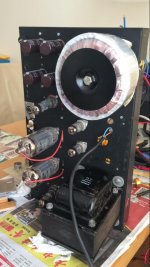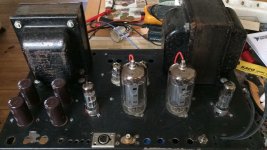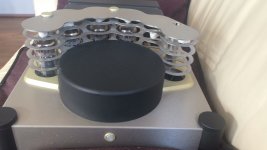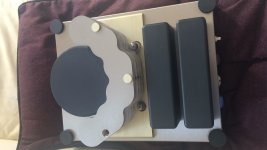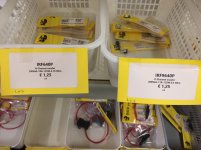sser2, and others,
Actually, with AC powered DHT filaments, the peak, minimum, and average Gm is not a constant.
It changes at 2X power mains frequency.
I suppose that effect in Push Pull, will cancel out.
But possibly you are left with balancing 2 different filaments, 2 potentiometers and 2 filament supplies.
And, if there is any magnetic attraction of the filaments to the steel plate, that too can modulate the plate current. Right Hand Rule says that the W (or M) filaments of a 300B, will have a magnetic term.
Each filament wire will be attracted to both sides of the plate. If one side is closer, the filament will move closer to that side of the plate, modulating the plate current.
These are small effects, but many readers of this forum, want to peel the onion all the way to those inner layers.
At some level of onion peeling, it becomes less appealing for us to go further.
That goes for Intermodulation distortion.
It also goes for hum.
Just how much hum do those commercial '30s Rauland PPP 2A3 amplifiers put out?
How much negative feedback, if any do they use for some hum cancellation?
Actually, with AC powered DHT filaments, the peak, minimum, and average Gm is not a constant.
It changes at 2X power mains frequency.
I suppose that effect in Push Pull, will cancel out.
But possibly you are left with balancing 2 different filaments, 2 potentiometers and 2 filament supplies.
And, if there is any magnetic attraction of the filaments to the steel plate, that too can modulate the plate current. Right Hand Rule says that the W (or M) filaments of a 300B, will have a magnetic term.
Each filament wire will be attracted to both sides of the plate. If one side is closer, the filament will move closer to that side of the plate, modulating the plate current.
These are small effects, but many readers of this forum, want to peel the onion all the way to those inner layers.
At some level of onion peeling, it becomes less appealing for us to go further.
That goes for Intermodulation distortion.
It also goes for hum.
Just how much hum do those commercial '30s Rauland PPP 2A3 amplifiers put out?
How much negative feedback, if any do they use for some hum cancellation?
Last edited:
Yes, if there is electromagnetic and/or electrostatic induced filament vibration, this will not cancel out.
I have never bothered to measure hum of those 2A3 amplifiers. They are dead quiet, more so than my HK300 6V6 amp. The 2A3 amp is no-feedback. I was surprised that there is no hum balancing pots, just grounded center tap of the common filament winding.
I have never bothered to measure hum of those 2A3 amplifiers. They are dead quiet, more so than my HK300 6V6 amp. The 2A3 amp is no-feedback. I was surprised that there is no hum balancing pots, just grounded center tap of the common filament winding.
electromagnetic and / or electrostatic filament vibrations, if any, will inter-modulate 2X the power mains frequency onto the musical notes.
Sidebands, no matter how small.
I remember Test and Cal of spectrum analyzers, where we looked for "Fan Sidebands".
They had to be -80dBc or better.
Some fans, and some oscillators and other parts were too sensitive, so we had to troubleshoot the offender(s), and fix them.
Sidebands, no matter how small.
I remember Test and Cal of spectrum analyzers, where we looked for "Fan Sidebands".
They had to be -80dBc or better.
Some fans, and some oscillators and other parts were too sensitive, so we had to troubleshoot the offender(s), and fix them.
There is no doubt that intermodulation originating from AC-powered filaments exists - in SE power stages. The question still remains about magnitude of this effect. How much is too much to justify the remedies offered, with their shortcomings?
Electrodynamic speaker, especially a full-range kind revered by SET topology admirers, produces order of magnitude more IMD than any amplifier with AC-powered filaments. And yet people are happy with these speakers and don't rush to replace them with something else.
Electrodynamic speaker, especially a full-range kind revered by SET topology admirers, produces order of magnitude more IMD than any amplifier with AC-powered filaments. And yet people are happy with these speakers and don't rush to replace them with something else.
What shortcomings did you find, which are noticeably most affecting the resulting sonic in a negative way?How much is too much to justify the remedies offered, with their shortcomings?
This implies your approach as "any expense, no matter how high, justifies any sonic improvement, no matter how small". I doubt that sonic differences between AC-and DC-powered filaments can be confirmed in a blind test.
Shortcomings of filament regulators are tangible.
- They cost money (important for a diy on a budget).
- They are awkward, whereas AC filaments are elegantly simple.
- They require types of power supplies that contaminate AC main frequency with high order harmonics.
- DC powering causes uneven wear of filament cathode.
Shortcomings of filament regulators are tangible.
- They cost money (important for a diy on a budget).
- They are awkward, whereas AC filaments are elegantly simple.
- They require types of power supplies that contaminate AC main frequency with high order harmonics.
- DC powering causes uneven wear of filament cathode.
Last edited:
.....you could even use a PL519 ( my personal favorite of all time ) with some adjustments ;-)
Best regards, Frank
Hey Lampie, please show us what you built with Pl519 tubes. I have some and I’m collecting good, proven designs. I will select one to build soon. Not to detract from the OP’s thread you could start a thread of your own or send me PM.
Regards,
Francois
Hello Francois,
Some links to other threads:
Rebuilding Beveridge Circuit Board Stators
Do any of you have the old Beveridge 'White Paper'?
Best Regards, Frank
Some links to other threads:
Rebuilding Beveridge Circuit Board Stators
Do any of you have the old Beveridge 'White Paper'?
Best Regards, Frank
Please explain "triode connected" as it can be done multiple ways. This tube has 3 grids that all can be used seperately or together etc.
BTW, as i do not use any OT i do not care about this.
Only when i "upgrade" existing PP poweramps i will use the exisiting OT (G2 as control grid and G1 shorted to C).
In the past i used them in "Futterman" style OTL amps (that is more then 20 years ago now).
BTW, as i do not use any OT i do not care about this.
Only when i "upgrade" existing PP poweramps i will use the exisiting OT (G2 as control grid and G1 shorted to C).
In the past i used them in "Futterman" style OTL amps (that is more then 20 years ago now).
Attachments
Sad it is not open these days.... i am addicted to shopping there...
OOOPS, Sorry, no tubes...
OOOPS, Sorry, no tubes...
Attachments
Last edited:
I am missing a used electronics shop in St. Louis some 25 years ago. A lot of riff-raff, new stuff almost every week, each time something exciting. Back room with racks of loose tube boxes, small ones $1, big ones $3, took me many visits to go through all boxes. Still have 5 or 6 EL519 from that shop. Closed in '96, not enough customer base.
Baco is quite a famous shop around here, they mostly deal in mil surplus stuff but do electronics on the side. There are around three real surplus stores still standing. If electronics parts is your bread and butter, chances are you will go belly up trying to compete. Because the electronics hobbyists are either well stocked like myself, or real cheap and will come in and take up your time for 5 3 cents resistors.
The rest is some of the vendors that only do tables at the HAM and vintage radio meets. A couple of semi-hobbyists.
The rest is some of the vendors that only do tables at the HAM and vintage radio meets. A couple of semi-hobbyists.
- Home
- Amplifiers
- Tubes / Valves
- What tube?
